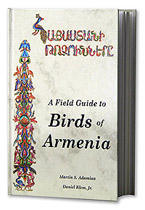- Pictures of All Birds
- Find Bird by Common Name
- Find Bird by Scientific Name
- Find Bird by Armenian Name
- Orders of Birds
- Distribution Maps
- Location of Armenia
- Species of Special Concern

Purchase the Field Guide
© Copyright Birds
of Armenia Project
ForewordA Field Guide to Birds of Armenia clearly and effectively documents the bird life of a region largely unknown in the West but richly endowed with biological and cultural diversity. Here an international team of expert ornithologists shines the international spotlight on the fascinating birds of Armenia in one of the world’s newest and very best regional field guides. The authors and their expert collaborators describe the beauty and pleasure of Armenian birds and their diverse habitats. No other work offers such effective descriptions of Armenian birds. The detailed knowledge of species distributions and relative abundances will promote and ensure wise stewardship of birds as a valuable Armenian natural resource. An especially valuable contribution is the identification of species that are suspected or known to be at risk. Highlighting these species of special concern will encourage Armenian as well as international conservation efforts to maintain and, when appropriate, rebuild viable populations to these lands. Special thanks are due from the world community of bird conservation to the team members who devoted their time and expertise to the writing of this attractive and authoritative book. I can think of no better or more timely way to enhance environmental awareness in the new and emerging nation of Armenia. Every contributor should be proud of this contribution to Armenia: its birds, its people, and any others who will visit its spectacular landscapes. A Field Guide to Birds of Armenia does what books of this type do best. It opens new and exciting worlds to more people. It offers fundamental knowledge to help ensure that these exquisite animals will enrich the lives of future generations of Armenians. This book thus joins an elite library of works that contribute magnificently to avian conservation and regional environmental health. Frank B. Gill, Ph.D.
The value of A Field Guide to Birds of Armenia, however, extends far beyond the reaches of regional and international birding. In the capable hands of Armenian field ornithologists and ecologists, Adamian and Klem — as the work will surely come to be known — will be used to document and improve the known ranges of numerous species of birds, helping to solidify our knowledge of the region’s bird life. Over the years, the guide promises to train hundreds of undergraduate and graduate students, who in turn will ensure the rapid development of ornithology and ecology in Armenia. Even more importantly, the guide will help Armenian educators and conservationists demystify and explain the country’s natural habitats. By opening the world of birds to the people of Armenia, Adamian and Klem will provide a shortcut to essential lessons in habitat management and the protection of natural resources. Once identified and appreciated, Armenia’s birds will serve as conservation flagships and biological indicators, as well as sources of ecotourism revenue. The guide includes up-to-date and in-depth information on all of Armenia’s currently recognized 346 species of birds — an outstanding level of biological diversity given the country’s relative size and latitude. A glimpse at the book’s species accounts, for example, reveals that Armenia has 35 species of diurnal birds of prey — exactly as many as occur in all of North America! All are covered in considerable detail. This detailed attention is true of all the bird descriptions in the book. Even a cursory reading of the guide reveals a thoroughness and attention to detail that promise to make A Field Guide to Birds of Armenia an instant classic among the world’s birders and field ornithologists, alike. The principal virtue of the guide is that it contains all that is needed to find and identify birds in Armenia. The illustrations are better than I have seen in any field guide; the text is both straightforward and authoritative; the layout, superb; and the binding sufficient to withstand the rigors of extended field use. The authors, contributors, and producers of the book are to be congratulated for their efforts. I have no doubt that the current volume will serve the birding, ornithological, educational, and conservation communities of Armenia well into the twenty-first century. The work provides the first complete, authoritative, and portable guide to the birds of Transcaucasia. Keith L. Bildstein, Ph.D.
|
||||||||||||